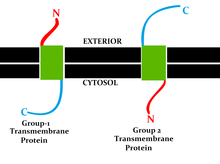Integral membrane protein
An integral, or intrinsic, membrane protein (IMP)
Proteins that adhere only temporarily to cellular membranes are known as peripheral membrane proteins. These proteins can either associate with integral membrane proteins, or independently insert in the lipid bilayer in several ways.
Structure
Three-dimensional structures of ~160 different integral membrane proteins have been determined at
IMPs can be divided into two groups:
- Integral polytopic proteins (Transmembrane proteins)
- Integral monotopic proteins
Integral polytopic protein
The most common type of IMP is the transmembrane protein, which spans the entire biological membrane. Single-pass membrane proteins cross the membrane only once, while multi-pass membrane proteins weave in and out, crossing the membrane several times. Single pass membrane proteins can be categorized as Type I, which are positioned such that their carboxyl-terminus is towards the cytosol, or Type II, which have their amino-terminus towards the cytosol. Type III proteins have multiple transmembrane domains in a single polypeptide, while type IV consists of several different polypeptides assembled together in a channel through the membrane. Type V proteins are anchored to the lipid bilayer through covalently linked lipids. Finally Type VI proteins have both transmembrane domains and lipid anchors.[4]

Integral monotopic proteins
Integral monotopic proteins are associated with the membrane from one side but do not span the lipid bilayer completely.
Extraction
Many challenges facing the study of integral membrane proteins are attributed to the extraction of those proteins from the
Determination of protein structure
The
Function
IMPs include transporters, linkers, channels, receptors, enzymes, structural membrane-anchoring domains, proteins involved in accumulation and transduction of energy, and proteins responsible for cell adhesion. Classification of transporters can be found in Transporter Classification Database.[7]
As an example of the relationship between the IMP (in this case the bacterial phototrapping pigment, bacteriorhodopsin) and the membrane formed by the phospholipid bilayer is illustrated below. In this case the integral membrane protein spans the phospholipid bilayer seven times. The part of the protein that is embedded in the hydrophobic regions of the bilayer are alpha helical and composed of predominantly hydrophobic amino acids. The C terminal end of the protein is in the cytosol while the N terminal region is in the outside of the cell. A membrane that contains this particular protein is able to function in photosynthesis.[8]
Examples
Examples of integral membrane proteins:
- Insulin receptor
- Some types of NCAMs, or selectins
- Some types of receptor proteins
- Glycophorin
- Rhodopsin
- Band 3
- CD36
- Glucose Permease
- Ion channelsand Gates
- Gap junction Proteins
- Beta-adrenergic receptor)
- Seipin
- Photosystem I[9]
See also
- Membrane protein
- Transmembrane protein
- Peripheral membrane protein
- Annular lipid shell
- Hydrophilicity plot
- Inner nuclear membrane protein
References
- ^ "intrinsic protein | biology". Britannica. Retrieved 2022-07-04.
- ISBN 978-0-12-370458-0. Retrieved 24 November 2010.
- PMID 9568909.
- ^ Nelson, D. L., & Cox, M. M. (2008). Principles of Biochemistry (5th ed., p. 377). New York, NY: W.H. Freeman and Company.
- PMID 30174558.
- PMID 21685390.
- PMID 19022853.
- ^ "Integral membrane proteins". academic.brooklyn.cuny.edu. Archived from the original on 1 February 2015. Retrieved 29 January 2015.
- PMID 3333014.
